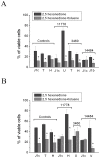The background of mitochondrial DNA haplogroup J increases the sensitivity of Leber's hereditary optic neuropathy cells to 2,5-hexanedione toxicity
- PMID: 19936068
- PMCID: PMC2774515
- DOI: 10.1371/journal.pone.0007922
The background of mitochondrial DNA haplogroup J increases the sensitivity of Leber's hereditary optic neuropathy cells to 2,5-hexanedione toxicity
Abstract
Leber's hereditary optic neuropathy (LHON) is a maternally inherited blinding disease due to mitochondrial DNA (mtDNA) point mutations in complex I subunit genes, whose incomplete penetrance has been attributed to both genetic and environmental factors. Indeed, the mtDNA background defined as haplogroup J is known to increase the penetrance of the 11778/ND4 and 14484/ND6 mutations. Recently it was also documented that the professional exposure to n-hexane might act as an exogenous trigger for LHON. Therefore, we here investigate the effect of the n-hexane neurotoxic metabolite 2,5-hexanedione (2,5-HD) on cell viability and mitochondrial function of different cell models (cybrids and fibroblasts) carrying the LHON mutations on different mtDNA haplogroups. The viability of control and LHON cybrids and fibroblasts, whose mtDNAs were completely sequenced, was assessed using the MTT assay. Mitochondrial ATP synthesis rate driven by complex I substrates was determined with the luciferine/luciferase method. Incubation with 2,5-HD caused the maximal loss of viability in control and LHON cells. The toxic effect of this compound was similar in control cells irrespective of the mtDNA background. On the contrary, sensitivity to 2,5-HD induced cell death was greatly increased in LHON cells carrying the 11778/ND4 or the 14484/ND6 mutation on haplogroup J, whereas the 11778/ND4 mutation in association with haplogroups U and H significantly improved cell survival. The 11778/ND4 mutation on haplogroup U was also more resistant to inhibition of complex I dependent ATP synthesis by 2,5-HD. In conclusion, this study shows that mtDNA haplogroups modulate the response of LHON cells to 2,5-HD. In particular, haplogroup J makes cells more sensitive to its toxic effect. This is the first evidence that an mtDNA background plays a role by interacting with an environmental factor and that 2,5-HD may be a risk element for visual loss in LHON. This proof of principle has broad implications for other neurodegenerative disorders such as Parkinson's disease.
Conflict of interest statement
Figures




Similar articles
-
Leber's Hereditary Optic Neuropathy-Specific Mutation m.11778G>A Exists on Diverse Mitochondrial Haplogroups in India.Invest Ophthalmol Vis Sci. 2017 Aug 1;58(10):3923-3930. doi: 10.1167/iovs.16-20695. Invest Ophthalmol Vis Sci. 2017. PMID: 28768321
-
The role of mtDNA background in disease expression: a new primary LHON mutation associated with Western Eurasian haplogroup J.Hum Genet. 2002 Feb;110(2):130-8. doi: 10.1007/s00439-001-0660-8. Epub 2002 Jan 24. Hum Genet. 2002. PMID: 11935318
-
[The influence of mitochondrial haplogroup on Leber's hereditary optic neuropathy].Zhonghua Yi Xue Yi Chuan Xue Za Zhi. 2008 Feb;25(1):45-9. Zhonghua Yi Xue Yi Chuan Xue Za Zhi. 2008. PMID: 18247303 Review. Chinese.
-
Extremely low penetrance of Leber's hereditary optic neuropathy in 8 Han Chinese families carrying the ND4 G11778A mutation.Ophthalmology. 2009 Mar;116(3):558-564.e3. doi: 10.1016/j.ophtha.2008.10.022. Epub 2009 Jan 22. Ophthalmology. 2009. PMID: 19167085 Free PMC article.
-
Leber's Hereditary Optic Neuropathy as a Promising Disease for Gene Therapy Development.Adv Ther. 2019 Dec;36(12):3299-3307. doi: 10.1007/s12325-019-01113-2. Epub 2019 Oct 11. Adv Ther. 2019. PMID: 31605306 Free PMC article.
Cited by
-
Mitochondria in Retinal Ganglion Cells: Unraveling the Metabolic Nexus and Oxidative Stress.Int J Mol Sci. 2024 Aug 7;25(16):8626. doi: 10.3390/ijms25168626. Int J Mol Sci. 2024. PMID: 39201313 Free PMC article. Review.
-
Mitochondrial DNA sequence variation and haplogroup distribution in Chinese patients with LHON and m.14484T>C.PLoS One. 2010 Oct 18;5(10):e13426. doi: 10.1371/journal.pone.0013426. PLoS One. 2010. PMID: 20976138 Free PMC article.
-
A multi-parametric workflow for the prioritization of mitochondrial DNA variants of clinical interest.Hum Genet. 2016 Jan;135(1):121-36. doi: 10.1007/s00439-015-1615-9. Epub 2015 Nov 30. Hum Genet. 2016. PMID: 26621530 Free PMC article.
-
Whole Mitochondrial Genome Analysis in Serbian Cases of Leber's Hereditary Optic Neuropathy.Genes (Basel). 2020 Sep 2;11(9):1037. doi: 10.3390/genes11091037. Genes (Basel). 2020. PMID: 32887465 Free PMC article.
-
Somatic point mutations in mtDNA control region are influenced by genetic background and associated with healthy aging: a GEHA study.PLoS One. 2010 Oct 14;5(10):e13395. doi: 10.1371/journal.pone.0013395. PLoS One. 2010. PMID: 20976236 Free PMC article.
References
-
- Carelli V, Ross-Cisneros FN, Sadun AA. Mitochondrial dysfunction as a cause of optic neuropathies. Prog Retin Eye Res. 2004;23:53–89. - PubMed
-
- Carelli V, Giordano C, d'Amati G. Pathogenic expression of homoplasmic mtDNA mutations needs a complex nuclear-mitochondrial interaction. Trends Genet. 2003;19:257–262. - PubMed
Publication types
MeSH terms
Substances
Grants and funding
LinkOut - more resources
Full Text Sources

